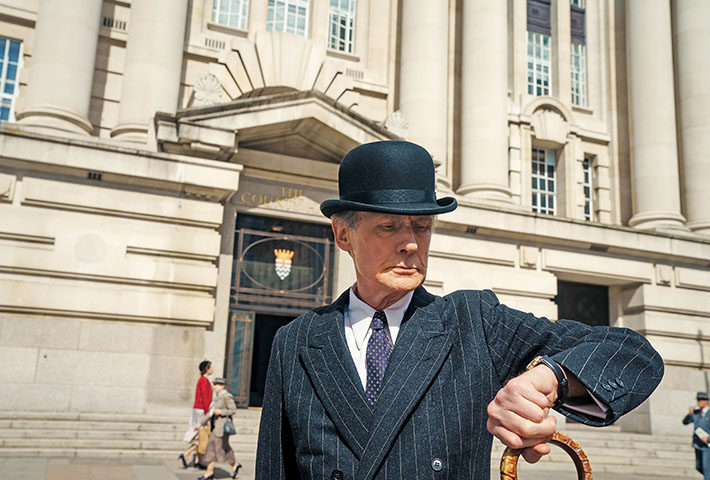
The quietly powerful Living defies expectations at every turn. As the film starts, we meet Mr. Wakeling (his given name happens to be Peter, but that’s of little consideration in this film), played by Alex Sharp. It’s his first day of work at the department of public works in 1950s London. We see him meet his new co-workers at the train station. They are dressed alike, in suits and bowler hats, and there is a grim, almost funereal mood among them. Wakeling, nervous and polite to a fault, tries to start small talk but is immediately shut down. These bureaucrats don’t do small talk.
Later that day, he will meet his boss, Mr. Williams (Bill Nighy), who unsmilingly sits behind a large desk and has a habit of filing requests into a vague pile stacked up in his inbox. “We can keep here it for now,” he says. “No harm.” Translation: Whatever the request was, it will never see the light of day again.
On that first day, Wakeling sees exactly how the government office works. Requests are made—in this case, it’s three women determined to turn an abandoned lot in their neighborhood into a playground—and punted around from department to department: sanitation, parks and recs, and finally public works where it ends up in Mr. Williams’ purgatorial pile.
And here comes the first surprise: The cute and sweet Mr. Wakeling is not the film’s central character, it’s the stiff Mr. Williams. (Okay, I suppose the fact that the great British character actor Nighy plays Williams is one clue.)
That very same day, Williams finds out that he’s dying of cancer and has roughly six months to live. It makes him take stock of his life—and he realizes that he hasn’t really been living at all. I had heard that Living was a film about a dying man who chooses to embrace life in his final months and I expected something far more over the top—showgirls and sex clubs and boisterous bar hopping with his arms draped around new comrades. And while there’s a small bit of that, Living is far more modest and decorous than that. (You’ll have to wait for the American remake.)
Shortly after his diagnosis, Williams goes to a resort town where he meets a dissolute young playwright named Sutherland (Tom Burke, of The Souvenir) who specializes in smutty productions. “I came here to live a little, but I don’t know how,” Williams confesses. So Sutherland does, in fact, take the old man out for a night on the town. But the evening becomes more elegiac than raucous as Williams ends up singing the mournful Scottish folk song, “The Rowan Tree” at a piano bar and dissolves into tears before he can finish.
There are other characters central to the plot: First there’s Margaret, aka Miss Harris (a wonderful Aimee Lou Wood), who works in the public works office, but has just applied for a new job at a restaurant. She has a winking bonhomie about her, and Wakeling is instantly smitten. Williams is taken with her, too, but in a different way—he comes to see the youthful and casually exuberant Margaret as everything he is not: full of hope and joy and verve.
Then there’s Williams’ son and daughter-in-law, who have no idea he’s dying and think he’s having an affair with Margaret. (They also desperately want him to give up the big house the three of them share together, so they can get on with their lives without him.)
Living, which is a remake of an Akira Kurosawa film, is beautifully filmed and carefully told. It’s almost too careful at times. The film’s restraint is clearly an intentional choice by director Oliver Hermanus, meant to reflect the repression and drabness of Williams’ existence, but it can be a bit frustrating. “It’s never easy, this,” Williams’ doctor says, after delivering his prognosis. “Quite,” replies Williams. (There wasn’t a wet eye in the house.) Additionally, the old bureaucrat never musters up the nerve (or desire, really) to tell his son or daughter-in-law about his cancer. And when he does tell Margaret about his illness, he starts with: “It’s really quite boring, actually. . . .” (I suppose, in a way, that’s true.)
But such is the way of these stiff-upper-lip Brits. Williams takes a month off of work and when he returns, no one confronts him about it—that would be vulgar. While gone, he has switched from a bowler to a fedora, setting off something of a mild scandal in the office. The film makes it clear that a bureaucratic life has a way of sucking the humanity right out of you.
If I have another minor quibble with Living, it’s that its central conceit feels a bit too neat for me. That playground I mentioned earlier? It also doubles as a convenient metaphor. Williams tells Margaret that life should be more like childhood, when we frolic and play in playgrounds and resist when our mothers call us inside for supper. The fact that he is given an opportunity to build a playground is rather on the nose.
But still. Living is lovely. Beautifully acted by Nighy, who resists twinkly-eyed sentimentality at every turn, making his character all the more moving, and smartly directed by Hermanus, who makes surprising and well-considered choices throughout. Another unexpected thing happens about two-thirds through the film. Not a Shyamalan style twist—let’s not get carried away. But a narrative choice that is both bold and interesting. From start to finish, Living is a just a little bit better than it needs to be.
